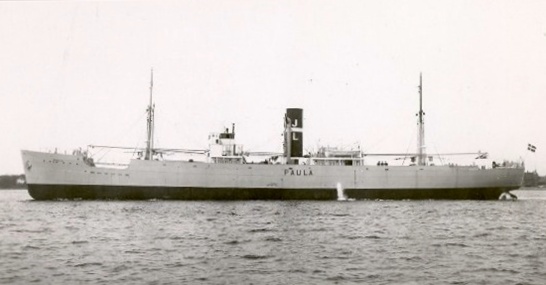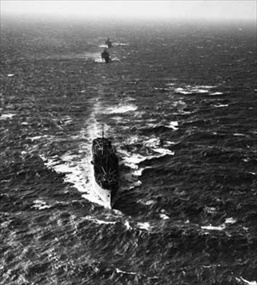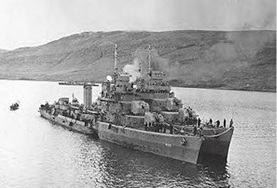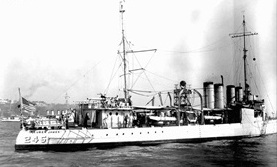ROOSEVELT—U-BOATS ARE “RATTLESNAKES OF THE ATLANTIC”
Washington, D.C. • September 11, 1941
Starting on September 1, 1941, two years into the Battle of the Atlantic, U.S. warships began escorting convoys of eastbound merchantmen from the North American coast. Convoys departed from Newfoundland, Canada, and ended in the mid-Atlantic at the Danish dependency of Iceland, the halfway point to ports in the British Isles. Four days after initiating the escort service, on September 4, 1941, the escort destroyer USS Greer, steaming 175 miles southwest of Iceland, observed a British plane dropping four depth changes on an underwater object, later identified as U‑652. The Greer’s skipper, having made sound contact with the U‑boat, decided to shadow it after the British aircraft inexplicably left the area. For whatever it was worth, the Greer repeatedly radioed the sub’s position. Suddenly, the U‑boat changed course, closed in on the Greer, and launched a torpedo at the U.S. destroyer, which it dodged. In retaliation the Greer heaved eight depth charges, then eleven more over its sides, avoiding being struck by a second enemy torpedo. The Greer was the first American warship to be attacked in the undeclared naval war between the neutral U.S. and Nazi Germany. (In a quid pro quo German aircraft sank an American merchant ship, a U.S. flag prominently painted on its side, in the Red Sea the very next day.)
In a radio broadcast on this date, September 11, 1941, in Washington, D. C, President Franklin D. Roosevelt called Nazi submarines and merchant raiders “rattlesnakes of the Atlantic” and issued a “shoot on sight” order. “If you see a rattlesnake poised to strike,” the president said, “you do not wait until he has struck before you crush him.” German and Italian ships entering American defensive waters did so at their own risk, and any of their ships that threatened the free passage of U.S. merchant ships and U.S.-escorted ships—including ships of other nations—risked attack. As proof of America’s commitment to protect transatlantic shipping from Axis predators, the U.S. Navy had authorized the construction six months earlier (April 18, 1941) of two destroyer and several seaplane bases on British soil. U.S. armed forces were now stationed in Europe as first-line defenders without any declaration of war.
Grand Admiral Erich Raeder, head of the Kriegsmarine, told Adolf Hitler that the U.S., though technically still a neutral nation, had declared war on Germany: “There is no longer any difference between British and American ships.” Hitler stayed his hand for the moment against the U.S. Just over a month later a U‑boat wolf pack managed to torpedo six out of 50 eastbound merchantmen being escorted by U.S. and Canadian warships. On October 17, 1941, the U.S. destroyer Kearny, which had been summoned to assist the beleaguered convoy, was attacked by U‑568 northwest of Iceland and damaged. Twenty-two American sailors were wounded and 11 killed, the first to die under their own flag in the European Theater since World War I.
Roosevelt’s response was prophetic: “We have wished to avoid shooting. But the shooting has started. And history has recorded who fired the first shot. In the long run, however, all that will matter is who fires the last shot.” But FDR kept his pistol holstered, even on October 31, 1941, the day U‑552 sank the first U.S. Navy vessel, the USS Reuben James, west of Iceland with a loss of 100 crewmen. Germany called the Reuben James fair game because the U.S. destroyer was escorting British merchant ships. So that’s where things stood between the two powers until December 7, 1941, the date of the Japanese surprise attack on the U.S. fleet and airfields at Pearl Harbor, Hawaii. Without technically being forced or even obligated by treaty to do so, Hitler declared war on the United States four days later as a gesture of Axis solidarity with Japan, a country on the other side of the world. The December 11 declaration was, Hitler told his foreign minister, Joachim von Ribbentrop, the “politically correct” thing to do.
![]()
U.S. Merchant Marine and Navy on the Eve of War with Germany, 1941
 |  |
Left: On September 11, 1941, the same day President Roosevelt made his fireside chat, a speech that became known as his “Shoot on Sight Speech,” the unescorted and neutral Panamanian-flagged freighter Montana (former Danish name, Paula) was sunk by the German submarine U‑105. Owned by the U.S. Maritime Commission in Washington, D.C., the ex-Danish ship was carrying lumber from Wilmington, North Carolina, to Reykjavik, Iceland’s capital. Allied aircraft observed survivors abandoning ship in two lifeboats, but the crewmen were never found. Nine days later the U.S.-Panamanian freighter Pink Star, carrying general cargo from New York to Liverpool, England, was sunk by U‑552. Thirteen out of the crew of 35 died. On September 26 the U.S.-Panamanian oil tanker I.C. White was sunk by U‑66 while sailing from the Caribbean island of Curaçao to Cape Town, South Africa. Three men died in this attack. The tanker was unescorted, unarmed, and fully lit. On October 9, Roosevelt began his successful efforts to modify the U.S. Neutrality Acts to allow the arming of merchant ships. A November 5, 1941, Gallup poll indicated that 81 percent of the American public supported the President’s move. On December 2 the U.S. merchant ship SS Dunboyne received the first Naval Armed Guard detachment. Its members were among the 144,970 enlisted men and officers who served in the U.S. Navy Armed Guard during World War II.
![]()
Right: On September 17, 1941, five American destroyers began escorting convoy HX150 from Halifax, Canada. This was the first time the U.S. Navy escorted an eastbound British transatlantic convoy. This photo from late 1941 shows a convoy escorted by U.S. warships leaving New York’s Brooklyn harbor bound for Great Britain via Halifax.
 |  |
Left: USS Kearny at Hvalfjordur naval base near Reykjavik, Iceland, two days after the destroyer had been struck by one of three torpedoes fired by U‑568 on October 17, 1941. Sister escort destroyer USS Greer is portside. The cavernous torpedo hole is visible in the middle of Kearny’s starboard side below and aft of the bridge. The Kearny, assisting four other U.S. warships, came to the nighttime rescue of the beleaguered, slow-moving convoy SC‑48 whose Canadian escorts were being mauled by a U‑boat wolf pack when it came under attack in bad weather. Two American ships were sunk during the attack, causing dozens of casualties: the British-flagged Anglo-American Oil Co. tanker W.C. Teagle and the U.S.-Panamanian freighter Bold Venture sailing for Liverpool, England, with a cargo of cotton, iron, steel, copper, and wood. Casualties among Kearny’s crew included 11 dead and 22 injured. In FDR’s Navy Day speech on October 27, 1941, 6‑1/2 weeks before the country was officially at war with Germany, the former Undersecretary of the U.S. Navy and now president announced, “The shooting has started and we Americans have taken our battle stations.”
![]()
Right: USS Reuben James—a four-funnel, post-World War I destroyer—was sunk on the night of October 30/31, 1941, by U‑552 west of Iceland as she and four other destroyers escorted HX156, an eastbound convoy sailing from Argentia, Newfoundland. A torpedo hit the forward section of the Reuben James. When an ammunition magazine exploded it blew off the entire bow of “Ol’ Rube,” which sank immediately; the aft section sank five minutes later. Of the 144‑man crew, only 44 survived. Tragically, many of the crewmembers were killed by the escort destroyer’s own unsecured depth charges, which armed themselves in frigid ocean water and exploded as the men treaded water (ship’s lifeboats were rendered unusable). Counting the conflict in China, the Reuben James was the second U.S. Navy ship sunk by hostile action in World War II. The river gunboat USS Panay, serving in the U.S. Yangtze Patrol in China, was bombed, strafed, and sunk by Japanese aircraft on December 12, 1937, with a loss of 4 dead and 43 sailors and 5 civilians wounded.
American Merchant Marine and Singer-Songwriter Woody Guthrie Performing His “Sinking of the Reuben James” to a Collage of Reuben James Photographs
![]()

 History buffs, there is good news! The Daily Chronicles of World War II is now available as an ebook for $4.99 on Amazon.com. Containing a year’s worth of dated entries from this website, the ebook brings the story of this tumultuous era to life in a compelling, authoritative, and succinct manner. Featuring inventive navigation aids, the ebook enables readers to instantly move forward or backward by month and date to different dated entries. Simple and elegant! Click
History buffs, there is good news! The Daily Chronicles of World War II is now available as an ebook for $4.99 on Amazon.com. Containing a year’s worth of dated entries from this website, the ebook brings the story of this tumultuous era to life in a compelling, authoritative, and succinct manner. Featuring inventive navigation aids, the ebook enables readers to instantly move forward or backward by month and date to different dated entries. Simple and elegant! Click 











